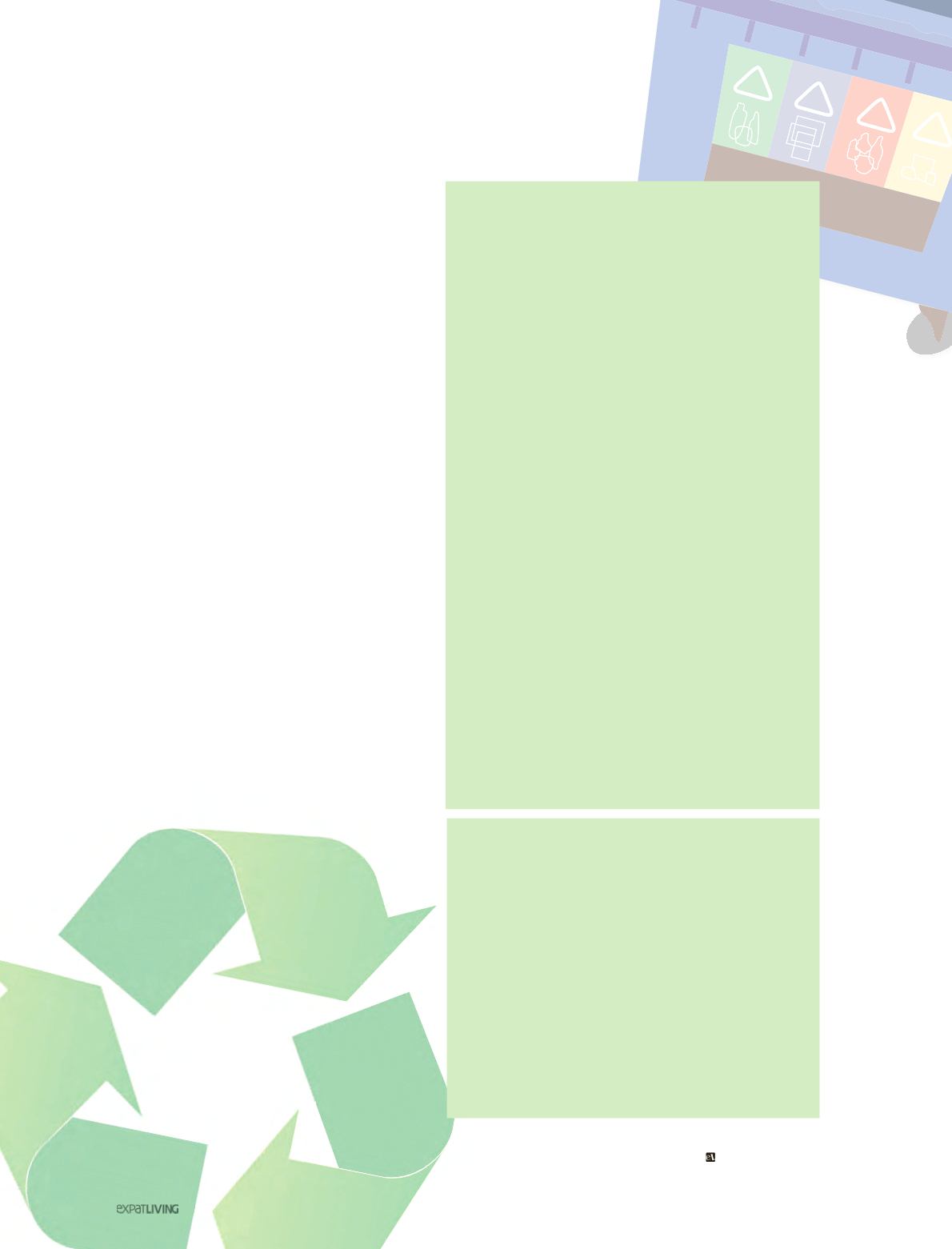

LIFE&FAMILY
146
July14
RECYCLING IN SINGAPORE &
AROUND THE WORLD
I
n Singapore, four waste-to-energy (WTE) plants
incinerate waste that is not separated for recycling.
According to a spokesperson for NEA, a fifth plant is
under construction and the government has put a sixth
out for tender, as the first is de-commissioned. In 2012,
Singapore’s incinerable solid waste could fill 990 football
fields to the height of an average person. Recycling helps
reduce this amount.
A national recycling programme was launched in 2001,
and the rate across all sectors in 2013 was 61 percent
(
see table, below right
). Improving this number is reliant
on recycling becoming an accepted social norm across all
communities. Dr Catherine Yeung from NUS says people
typically follow social norms when two conditions are met:
it is socially acceptable
and
everybody else is doing it. In
the case of recycling, she says, the first condition has been
met, but the second condition falls down because we tend
to think that no one else is recycling.
Changing this norm starts with targeting a well-defined
group, for example schoolchildren, in the hope that their
recycling behaviours will spill over to other groups, including
parents. There are numerous examples in Europe, the UK
and Asia of successful and not-so-successful campaigns
to motivate and drive behavioural change.
In Taiwan, a campaign to encourage consumers and
businesses to recycle was launched in 1998. According
to Chen Hung-Yi of the Environmental Protection
Administration, it has been successful nationwide, with
a recycling rate of 40 percent reached in 2011; a target
of 75 percent has been set for 2020. The preferred solid
waste solution is recycling. Households and businesses are
charged for garbage collection, while recycling is free. The
government encourages businesses to collect recycled
materials through subsidies. South Korea and Japan use
similar systems.
In Austria and Belgium, recycling rates are well over
90 percent and the practice is so ingrained that it is
automatic behaviour, according to Christian Stiglitz, CEO
of the European Institute of Environmental Economics.
Ongoing communication campaigns with clear, consistent
and concise messages are essential to maintain these
rates. He believes that in high-rise buildings, the chute is to
blame for low recycling rates. And he questions why people
might be fine with carrying heavy shopping bags into their
apartments and yet not be prepared to carry much lighter
bags out for recycling.
In the UK, the recycling rate is 47 percent. The big
driver to reach 50 percent by 2020 is the lack of space
for landfill sites in a country where the cost of dumping
waste is an expensive $170 per tonne. Smartphone apps
are seen as one of the best ways to encourage recycling,
from reminding residents to put their bins out, to providing
information about what can and can’t be recycled.
Waste Statistics
Overall recycling rates, as a percentage, in 2013:
Construction debris
99
Used slag
97
Ferrous metal
97
Non-ferrous metals
84
Scrap tyres
88
Wood
77
Paper/cardboard
54
Horticultural waste
48
Glass
20
Food
13
Plastics
11
Textiles/leather
10
Total recycling rate for all waste:
61 percent
Statistics: NEA
For detailed information, lists of collectors for recycled goods,
and numerous resources, visit
nea.gov.sg
.
FAQ
What can be recycled?
Paper, cardboard, old clothing, bottles, drink cans and
containers made of metal, glass or plastic. Containers
should be emptied of their contents to prevent contamination
of other recyclables. Old clothing should be bagged.
What cannot be recycled?
Items with food and liquid waste, items with composite
materials, light bulbs, ceramics and porcelain.
Why are recycling bins not separated?
Waste separation is done at the Material Recovery Facility.
Are there any recycling plants in Singapore?
There are various facilities that recycle different types of
waste across the island. At the Sarimbun Recycling Park,
entrepreneurs operate recycling facilities at low costs to
boost the domestic waste industry. Located in Singapore’s
northwest, it contributed about 30 percent of total waste
recycled in 2012.
What about batteries?
Used batteries can be safely disposed of with household
waste, which ends up at the WTE incineration plants.
How can I recycle electrical and electronic waste?
Besides the various take-back schemes operated by
companies to collect unwanted electronic items for
recycling, used items that are in serviceable condition
can be donated, sold or exchanged at collection centres.
Households can also use the recycling bins to deposit their
e-waste. Check the NEA website for drop-off details.



















